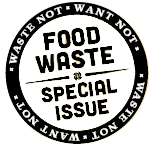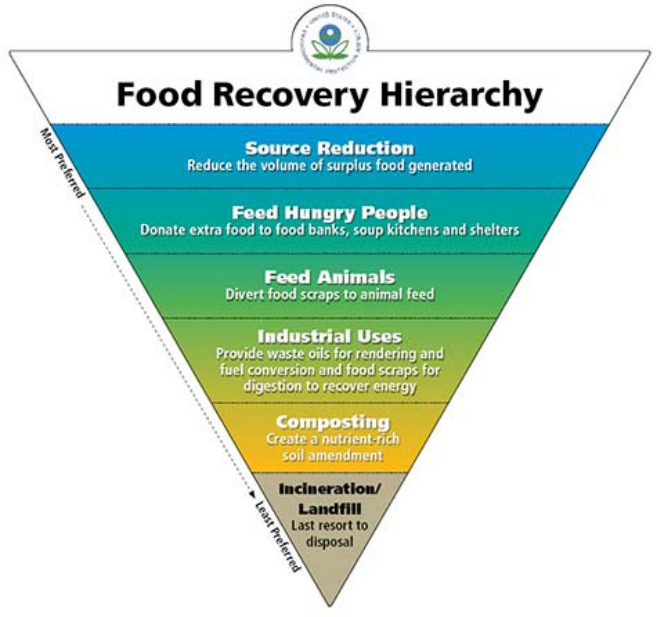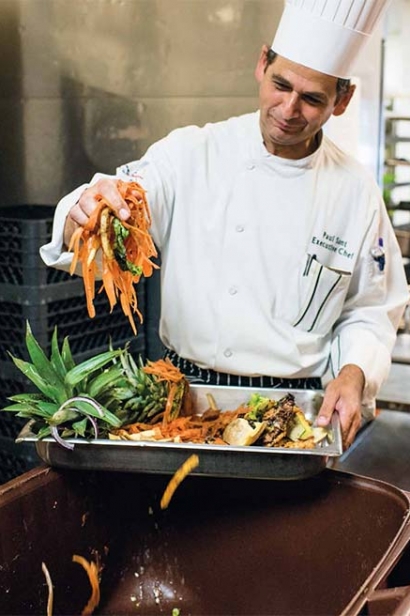Reducing Our Waste Line
Better solutions being found for all that uneaten food
Stationed like sentries in the kitchen at the Crowne Plaza Louisville Airport Hotel, a half-dozen brown compost bins are positioned to gobble up any food scraps not bound for someone’s belly.
Half-eaten biscuits, deserted scrambled eggs, potatoes on the way to petrification — anything edible left on the plate from the hotel’s restaurant, bar and banquet facilities ends up in a bin.
In June, that amounted to nearly 16,000 pounds of organic waste voluntarily diverted from the landfill and turned into useful compost thanks to a program administered by Louisville’s Solid Waste Management Services Division.
“I think we do have to do this,” said Executive Chef Paul Sant. “It’s not mandated, but I think we should do it because it’s the right thing to do. It wasn’t  because someone pressured us, it wasn’t because the millennial generation likes to see recycling, it was just the right thing to do.”
because someone pressured us, it wasn’t because the millennial generation likes to see recycling, it was just the right thing to do.”
What happens to food after it’s thrown away and forgotten in our homes, in our restaurants, in our hotels and schools and businesses? The vast majority ends up in a landfill — a simple answer to a complex problem that until recently has gone largely unexamined. In 2013 alone, more than 37 million tons of food waste was generated in the United States, with only 5% diverted from landfills and incinerators for composting, according to the U.S. Environmental Protection Agency. More food reaches landfills and incinerators than any other single material in our everyday trash, constituting 21% of discarded municipal solid waste.
In the Commonwealth, reducing food waste rests with grassroots initiatives and local municipalities as the state wrestles with budgetary constraints and apathy. Louisville’s Wet-Dry Recycling Program, for example, which Crowne Plaza participates in, is considered a visionary approach studied by experts in environmentally minded places like Seattle. Organics recycling at the state level, though, “probably falls into the category of things people want to get into down the road; it’s just not necessarily a high-profile, highly driven thing right now,” said Gary Logsdon, recycling and local assistance branch manager for the state Department of Environmental Protection.
With food waste in the U.S. estimated at roughly between 30% and 40% of the food supply, momentum to address the issue is beginning to take root. In September 2015, the U.S. Department of Agriculture, along with the EPA, launched a first-of- its kind domestic goal to reduce food loss and waste by half by 2030. More locally, the Southeast Recycling Development Council, which consists of 11 states including Kentucky, last November hosted the inaugural Food Recovery Summit to standing-room-only crowds.
“Food is becoming increasingly important to our government,” said Will Sagar, the council’s executive director. “We are realizing food has become a large part of waste in our landfills, so there’s an opportunity to see what can be done.”
A Local Solution
Louisville is working to seize that opportunity.
Officials for the first time recently hired a group of consultants to conduct a “waste characterization” of Jefferson County. Officials quickly determined the percentage of food that makes up the county’s waste stream was above the EPA’s 21% mark.
“That was eye-opening to us,” said Angela Futter, public education coordinator for the Department of Public Works’ Solid Waste Management Services Division. “We knew we had a pretty high percentage but we didn’t realize that it was higher than what we had anticipated.”
As officials looked at ways to reach the city’s goal of 90% diversion of waste from landfills by 2042, the Wet-Dry Recycling Program in the Central Business District took shape. It’s no secret Louisville is known for its burgeoning restaurant scene. But with that success comes something less appetizing: food waste.
The program, launched in March 2014, requires 46 restaurants to dispose of food waste in designated brown carts that are picked up by QRS Recycling and eventually end up at Smith Creek, a composting facility in Borden. Instead of going to a landfill, the food waste is composted into useable material, like mulch, that goes back into the community.
Before the program, the city recovered about 11% of all materials in the central business district headed to the landfill. “After implementing this program, up to the last couple of months, we’re able to get that recovery rate. [Of] what would have been sent to a landfill, we’re able to recover 80% of all that material,” Futter said.
At Crowne Plaza, recovering food waste has become a hotel-wide practice among employees, and not just the 33 kitchen staff and 100 food and beverage associates. It’s transcended language barriers and has endured morning and night shift changes.
“With any luck people will believe that recycling anything is a good thing,” Sant said. “I see it as a necessity and a need. We’re taking a lot from the Earth and I think this is something that’s important.”
Louisville’s program has been so successful that officials are eyeing expansion in another business district. But the cherry on top would be launching a residential program, which could happen as soon as next year. Similar to the business program, the residential initiative would require households to dispose of food waste and yard clippings in one container, and everything else in another.
Officials estimate the city could achieve a 75% recovery rate, “which is amazing,” Futter said.
“We are at 80% or above at what we are able to recover so we are excited about the possibility of moving this into residential,” she said. “I think that’s only natural that that’s the next step. I think Louisville is looking forward to the future. I think we are making strides in sustainability efforts all the time.”
Other parts of the country are taking note.
“There is not another program that is exactly like what we are doing,” Futter said. “We get phone calls all the time from people that want to know how to do this. When we have consultants come in to do this from Seattle, from Florida, from other places, they’re, like, ‘What is this program?’ Even they didn’t understand.”
“In 2010, an estimated 133 billion
pounds of food from U.S. retail food
stores, restaurants and homes never
made it into people’s stomachs,
according to the EPA. ”
A Multi-Layered Problem
Logsdon, with the state Department for Environmental Protection, and Sagar, with the Southeast Recycling Development Council, agree Louisville’s program is “cutting edge.”
But how to tackle food waste on a more comprehensive scale is a difficult nut to crack.
“The hard thing about food waste is we’re still wrapping our mind around where it’s happening and what to do with it and how do deal with it safely,” said Amanda Hege, director of community outreach for the Department of Dietetics and Human Nutrition at the University of Kentucky. It’s a dizzying, multi-faceted problem with many combinations of possible remedies.
Contributing to the confusion is everything from inconsistent food labels — “sell by” versus “use by” — to the super-size mentality “that we’ve developed in food marketing and we’re wearing around our hips at this point,” Sagar said, to infrastructure improvements to get useable food to donation facilities.
“This is a huge problem that’s going to take a lot of ways to solve,” Sagar said. “None of these ways are going to entirely fix it. How do we promulgate the understanding of rules better? Some of it may be rules changes and some of it may be understanding the rules we’ve got.”
At the state level, funding is at a premium. Recycling, as a whole, is struggling. “I don’t want to say we’re in a historic low, but we’re in a trough right now,” Logsdon said. “I think the assumption is it’ll go back up.”
With commodity prices at rock-bottom, it costs companies more to collect materials than what they make from recycling them. Compounding the issue: Other materials, like tires and electronic scrap, are higher on the state’s priority list, leaving organics as the odd waste out.
“People can compost at home,” Logsdon said. “You can’t compost electronics.” Over the past two years the state doled out $7 million in grants to help counties with recycling efforts. Food waste has been addressed at the county level. Franklin County, for example, has started a composting initiative with animal carcasses with the possibility of expanding into organics later in its three-year plan.
“We’ll look at that and hopefully expand,” Logsdon said. “When we send out requests for applications [for grants], we’ve specifically said we don’t do composting. If Franklin County is successful we may put a paragraph in the application packet that says we’re now accepting proposals for composting and food waste.” Until then, the outlook for organics recycling is bleak.
“It’s cheaper to go to the landfill than try to compost it and educate people,” said Donna Conway, internal policy analyst for the state Department for Environmental Protection’s Division of Waste Management.
Doing Their Part
In the Food Recovery Hierarchy developed by the EPA, the least preferred option is landfill/incineration. The second- most-preferred option, after reducing the volume of surplus food generated, is to feed hungry people.
In developed countries such as the United States, most wasted food is accumulated after reaching the market — at the retail, consumer and household levels, according to a report from the Academy of Nutrition Dietetics Foundation.
In 2010, an estimated 133 billion pounds of food from U.S. retail food stores, restaurants and homes never made it into people’s stomachs, according to the EPA.
Food is making its way to hungry bellies through food banks and donations from restaurants and grocery chains, as well as innovative programs at colleges. Kroger stores in the Kentucky market, for example, have donated 1.18 million pounds of fresh, nutritious foods so far this year through their Perishable Donation Partnership.
“This is the equivalent of 918,500 meals, and it all stays right here in our community,” said Kroger Louisville Division spokesman Tim McGurk.
The University of Kentucky’s Campus Kitchen Program collects unused food from the school’s dining facilities, as well as from food banks, grocery stores and farmers markets, and creates healthy meals for food insecure residents. Since 2014, the program has recovered more than 6,700 pounds of food and has served more than 5,200 meals.
“Food waste is a natural part of the food system,” Hege said. “The solution to decreasing waste depends on collaborations among restaurants, grocery stores, farms and farmers’ markets, community organizers and consumers. We all play an active part in reducing, reusing, recycling and reheating in order to divert quality food from ending in a landfill.”
Sant, the executive chef at Crowne Plaza, recently attended a Louisville Metro Council meeting in which sustainability was a topic of conversation. With the city’s wet-dry program gaining steam, he’s witnessed the recycling momentum firsthand.
“A lot of people are getting on this bandwagon,” he said. “I think it’s more than a trend. I think everyone is going to jump on this. It will either be mandatory or people realize it’s the right thing to do.”
INTEREST IN FOOD
BANKS PAYS DIVIDENDS

Map: KAFB 2015 Annual Report
The concept of food banking started 35 years ago when Phoenix, Arizona, resident John van Hengel met a desperate mother rummaging through grocery store garbage bins to find food for her children. As he talked with her, she suggested there be a place where discarded food could be stored for people to pick up, instead of ending up in the dumpster — a concept similar to the way “banks” store money for future use.
Shortly after, van Hengel established the nation’s first food bank, St. Mary’s Food Bank in Phoenix. In the first year, van Hengel and a group of volunteers distributed 275,000 pounds of food. Word spread quickly and by 1977, 18 cities across the country had established food banks.
Two years later, as their numbers increased, van Hengel created a national organization for food banks, called Second Harvest. The nonprofit organization took an evolutionary turn, adopting the name America’s Second Harvest the Nation’s Food Bank Network, and then in 2008 embraced its current name: Feeding America.
To date, Feeding America is the nation’s largest domestic hunger-relief organization, with 200 food banks across the United States, feeding 46 million people at risk of hunger, including 12 million children and seven million seniors. Read more at FeedingAmerica.org.
Kentucky Association of Food Banks (KAFB.org) is the state partner association for Feeding America, serving all 120 Kentucky counties in partnership with a network of over 1,000 local food pantries and shelters. In 2015, Kentucky Association of Food Banks members distributed 60.5 million pounds of food and grocery products — enough for 50.4 million meals. The organization reaches an estimated one in seven of all Kentuckians each year.
Eight nonprofits serve as members:
- Dare to Care
(Louisville)
DaretoCare.org - Feeding America
FeedingAmericaKY.org - Kentucky’s Heartland
(Elizabethtown) - Freestore Foodbank
(Cincinnati)
FreeStoreFoodBank.org - God’s Pantry
(Lexington)
GodsPantry.org - Facing Hunger Food Bank
(West Virginia, serving three eastern Kentucky counties)
FacingHunger.org - Tri-State Food Bank
(Evansville, Indiana, serving seven Kentucky counties)
TriStateFoodBank.org - Purchase Area Development District Food Bank
(eight-county region of Western Kentucky)
PurchaseADD.org






